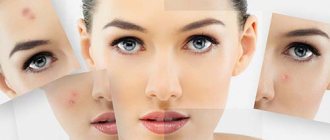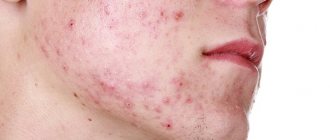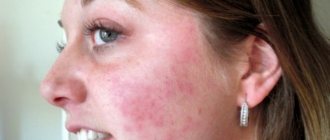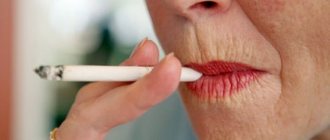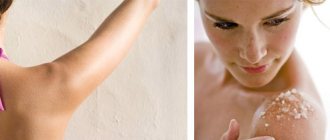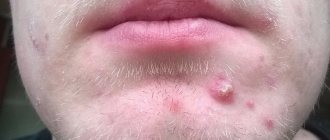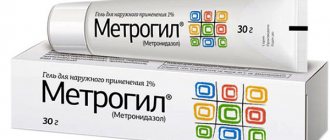Reasons for appearance
A pimple on the roof of the mouth can be the result of various abnormalities. For effective therapy, an accurate diagnosis must be made.
Dental diseases
The main cause of rash in the mouth is dental pathology. These include violation of hygiene rules, traumatic injuries, improper installation of prostheses and other factors.
With inflammatory damage to the tooth root, small pimples form. It may have a white or yellowish tint. As a rule, rashes on the palate are called stomatitis or inflammatory lesions of the mucous membranes.
Infections
Infectious pathologies also quite often cause rashes in the mouth. Most often this is observed in childhood. Cough, inflammation of the throat, and viral infections often provoke minor rashes.
Such pathologies are often accompanied by general weakness and increased body temperature. Subsequently, a white coating appears in the throat. This poses an even greater health hazard.
The child has
The cause of rashes in children is usually infectious diseases and other factors.
Common causes of acne on the palate include the following:
- Measles. In this situation, the rash appears as white-green papules. The rash disappears on its own after 2-3 days and does not require specific therapy.
In this case, the underlying disease must be treated. Otherwise there is a risk of dangerous consequences.
- Chickenpox. With this disease, rashes do not always affect the mucous membranes. However, sometimes this happens.
- Thrush. In this case, a white pimple with plaque appears. Sometimes it bleeds. The pathology does not pose a great danger, but can interfere with normal food intake.
- Dysbacteriosis. The disease often occurs in young children and is accompanied by the appearance of bloody pimples in the mouth. Pathology indicates disturbances in the composition of the intestinal microflora.
In an adult
The appearance of problems in adulthood may be due to the following factors:
- Herpetic infection. In this case, a transparent pimple filled with liquid may appear on the roof of your mouth. An exacerbation of the disease occurs against the background of a weakened immune system.
The disease does not require special therapy. However, it is important to avoid damaging the rash. Otherwise, this may cause the infection to spread.
- Glossitis. The cause of red bloody acne can be poor diet, drinking large amounts of alcohol, or allergies. In this case, small painful pimples form.
If treatment is not started in time, a crust will form on their surface. In such a situation, the doctor selects therapy.
- Syphilis. White pimples on the palate, which are not accompanied by pain, may appear due to infection with syphilis. The rash is varied in nature and affects different parts of the oral cavity.
- Inflammation of the tooth root. The appearance of white and yellow pimples can cause inflammatory damage to the tooth root.
In pregnant women
The main cause of problems during pregnancy is stomatitis. Its appearance is caused by an imbalance of hormones in the body. As a result, the immune system is weakened, and the mucous membranes lose the ability to cope with infection.
If this problem occurs during pregnancy, therapy should be started immediately. It should be selected by a doctor. The infection cannot be ignored as it can cause complications.
Acne around the mouth in women
If acne appears around the mouth in women, the reasons may be different:
- a consequence of hormonal fluctuations during pregnancy or the menstrual cycle,
- taking hormonal drugs,
- poor skin care or poor hygiene,
- lung disease, liver disease or gastrointestinal problems,
- low quality cosmetics,
- allergies to specific products or care products.
There can be many reasons. If, following all possible precautionary measures, you do not observe any changes, but on the contrary, the situation is only getting worse, then you should definitely contact a dermatologist .
Unlike oral dermatitis rashes, hormonal rashes are larger and are not located in groups, but separately in different places. They are also often accompanied by painful sensations.
Varieties
There are quite a few types of acne on the palate. Each of them is characterized by certain features.
Red
Such pimples usually affect the throat area and may indicate stomatitis, allergic reactions, or scarlet fever. The rash can also be a symptom of lupus erythematosus.
How to remove acne spots? More details here.
White
Such formations affect the mucous membranes of the oral cavity in infectious pathologies. These include the chronic form of tonsillitis, candidiasis, viral or bacterial stomatitis.
Solid
An internal pimple with a hard consistency often accompanies angioma. This dental disorder can have several types and is a benign tumor lesion of a blood vessel. It is associated with the expansion and appearance of new blood vessels.
The formation is called a true angioma and is accompanied by the appearance of a compaction on the palate. In addition, angioma is isolated that affects the lymph nodes. However, this form of the disease is observed much less frequently.
Prevention methods
To prevent such an unpleasant symptom, it is recommended to regularly monitor oral hygiene, prevent infection, avoid injury, avoid too hot food and drinks, etc.
You also need to adjust your diet, take immunomodulators and vitamin complexes. At the first unpleasant symptoms, consult a doctor who will help determine what kind of disease it is.
The patient should have regular dental checkups and treatment for existing conditions.
Conclusion
The appearance of acne in the mouth is accompanied by a number of unpleasant symptoms and indicates pathological processes in the body. The exact cause can be determined through a comprehensive examination.
The treatment regimen is selected by the doctor individually, based on the disease that caused the pimples in the oral cavity. Self-medication increases the chances of developing associated complications.
How to treat a pimple on the roof of your mouth
To cope with acne, you need to determine the exact causes of its appearance. Depending on this, you can select medications and folk remedies.
Pharmacy products
Treatment is selected depending on the causes of the rash. Most often, doctors prescribe antibacterial agents and drugs that help relieve inflammation. For severe pain, analgesics are prescribed.
To cope with the pathology, you need to strictly adhere to the doctor’s recommendations and not interrupt the course of therapy at the first symptoms of improvement.
To eliminate the symptoms of fungal stomatitis, antifungal agents are indicated - in particular, fluconazole. Antifungal gels can also be used.
Rinsing the mouth with antiseptic solutions helps to cope with acne on the palate. If allergies occur, you need to stop contact with allergens and take antihistamines.
Often, in addition to the main medications, general strengthening agents are prescribed. They help improve immunity and make it easier to fight pathology.
ethnoscience
Folk remedies can only be used in addition to main therapy. There are many diseases that cannot be treated with home remedies. Syphilis is one of these diseases. Therefore, this treatment can be used after consulting a doctor.
To cope with inflammation and itching, you can use a soda solution. To do this, mix 250 ml of warm water with half a small spoon of soda, mix thoroughly and use for rinsing several times a day.
Kalanchoe and aloe have a similar effect. The juice of these plants must be used to treat the affected areas of the oral cavity.
The following infusions are highly effective:
- Take 1 large spoon of oak bark, mix with 250 ml of boiling water, cool. Rinse your mouth with the strained product 4-5 times a day.
- Take 1 tablespoon each of calendula, chamomile and yarrow, add 250 ml of boiling water and leave for 20 minutes. Rinse your mouth with the strained mixture 3-4 times a day.
To prevent the proliferation of pathogenic bacteria in the oral cavity, it is worth using a solution of hydrogen peroxide with a concentration of 3%. To do this, 1 large spoon of the medicine should be mixed with a glass of water and used to rinse the mouth.
To combat bacteria, tea tree oil is perfect. To do this, it is recommended to add 3-5 drops of oil to a glass of water and keep the solution in your mouth for 1 minute. It is recommended to carry out the procedure up to 5 times a day.
At home
To alleviate your condition on your own, you need to follow these recommendations:
- maintain cleanliness of the oral cavity;
- do not injure acne;
- Avoid citrus fruits, spicy and salty foods - this will help avoid irritation of the affected areas;
- exclude sweets - this will help avoid creating an environment favorable for the development of pathogenic bacteria;
- eat more protein foods - fish, cheese, meat;
- drink a lot of clean water;
- Avoid drinking hot food and drinks.
Treatment
Patients who are faced with the appearance of acne near or inside the oral cavity are interested in which doctor to see.
First of all, you need to see a therapist and dermatologist. After the examination, they will refer you for tests and additional consultations with other specialists (ENT, immunologist, allergist, etc.).
- A small rash near the mouth may be a sign of an allergic reaction. To relieve unpleasant symptoms, take antihistamines.
- Treatment of acne on the lower mucosal cavity depends on the nature of the pathogen (viruses, bacteria or fungi). Depending on this, antiviral, antibacterial, and antimycotic drugs are used. The doctor selects the course and dosage individually.
- At high temperatures, antipyretic drugs are used (Nurofen, Panadol, etc.). For severe pain, antispasmodics and non-steroidal anti-inflammatory drugs are prescribed.
- Among traditional medicines, rinsing with decoctions of medicinal herbs (chamomile, St. John's wort, oak bark, etc.) is used. They help relieve inflammation and pain. Used as part of complex therapy.
- Experts recommend treating the oral cavity with solutions or sprays with antiseptics (Miramistin, Chlorhexidine, etc.). External preparations (ointments, gel, etc.) are popular. The duration of treatment depends on the disease that caused acne in the mouth.
- Rinsing with baking soda and salt helps to quickly cope with unpleasant symptoms. They help relieve swelling, redness and inflammation.
Photo: Nature of the rashes
How to remove acne scars on the face? Find out further.
How to remove acne marks on the face? The answer is here.
Acne outbreaks are a widespread problem that we all face at one time or another and try to get rid of them as quickly as possible. Most people are quite used to the appearance of pimples and acne on the chest, neck, face, shoulder and upper back. But the appearance of a pimple on The palate of the mouth is a cause of concern for most patients who come to the doctor with such a problem in themselves or their children.
If you have not previously experienced pimples in the mouth, it may seem strange to you to know that a pimple can appear in the mouth, especially on the hard upper palate and its part. Pimples on the roof of the mouth resemble regular acne, which also appears on the face.
At first, such inflammation begins as a minute bump that appears on the roof of the mouth and grows larger and larger over the next one or two days.
It is usually filled with pus, and if you press on a pimple on the roof of your mouth, it will burst just like a normal one.
The causes of acne on the roof of the mouth and body are very similar. They appear when the pores in this area become infected and clogged with a large amount of pus.
Mouth pimples are not that common, but you may be affected by the problem, especially if your body produces excess oils. Those who are vulnerable to frequent skin acne often notice pimples appearing on the roof of their mouth when they have the flu or fever. In addition to such inflammation, acne of this form can appear on any areas and parts of the body, including the inner walls of the nose or ear.
pimple on the inside of the lip
Hello my beauties!!! How are you feeling??? How are new habits taught?) Are you ready to move on?
MAIN POST HERE
Today we will look at one of the most important and difficult topics - determining the type and condition of your skin.
To begin with, I would like to note that skin type is given to a person at birth and depends on heredity and does not change throughout life.
The condition of facial skin depends on external factors and is the cause of premature aging, but it can be corrected.
It is extremely undesirable to confuse these two completely different concepts, because in the future this may lead to the wrong selection of products to care for your skin.
Thus, there are 4 main skin types: normal, oily, dry and combination.
Main skin conditions: dehydrated, stressed, sensitive, pigmented, skin with age-related changes.
In order to start taking care of your face, you first need to determine what type of skin you have. This can be done as follows: Using your fingertips, press firmly on the skin of your face, preferably on your cheekbones. If the pressure mark does not disappear immediately, it means that the skin is dry, inelastic and you need to use rich, nourishing and moisturizing creams. Using a small hand mirror, which should have been thoroughly washed and dried beforehand, touch your nose, forehead and cheeks. If marks are visible on the mirror, it means your skin is oily. This check can also be done using a paper napkin two hours after washing. Using light pressure with the blunt side of the pencil, draw a line from the forehead through the cheek to the chin. If a noticeable red mark remains, your skin is very sensitive and needs protection and requires gentle and caring care.
* Take the skin type test!
* We also read here and here)
And now about all this in more detail. In general, it is almost impossible to find specifically dry skin or specifically oily skin. Most women have combination skin, that is, it can be dry with a tendency to normal or normal with a tendency to oily.
Normal skin Normal skin looks clean and fresh, is tight, elastic, and lacks flaking. It has a pink tint (due to uniform blood supply) and is smooth and elastic to the touch. Normal skin contains enough moisture and oil. Pores, blackheads and wrinkles are almost invisible on it. Owners of such skin are truly lucky, since normal skin type is extremely rare!
Oily skin Oily skin is characterized by excessive shine due to increased oiliness and insufficient blood supply; excess oil clogs the pores. She is prone to pimples and blackheads and sometimes has a dirty appearance. The pores on it are sharply enlarged, often closed with black dots. The skin is quite rough, and before menstruation it becomes especially oily and inflamed. But oily skin has a huge advantage over others: it is quite insensitive, which means it will remain young for a long time. Abundantly released fat creates a protective film that prevents moisture from evaporating and blocks the penetration of harmful substances. And one more plus: with age, the condition of oily skin only improves and usually by the age of 30 it becomes mixed.
Dry skin
Dry skin can have different origins and therefore vary in appearance. In young and middle age, dry skin is “natural.” In this case, dry skin looks soft, thin, with a matte tint. The pores on it are invisible, but fine wrinkles may appear at a young age. Sometimes, in the absence of special care, it peels off, and a feeling of tightness or irritation may appear. Such skin reacts very strongly to changes in ambient temperature and does not tolerate soap, ointments and some emollient creams well. It should be borne in mind that excessive dry skin can be caused by a lack of fat in the body, both due to its low intake from food, and due to impaired fat metabolism due to diseases of the liver or pancreas. In addition, increased skin dryness may be associated with a deficiency of vitamins A, C, PP.
Combination (mixed) skin Mixed (combination) skin is very common. It is characterized by uneven distribution of fatty lubricant in different parts of the face. Usually on the nose, forehead, chin (the so-called T-zone) the skin has all the signs of oily, that is, it is constantly shiny, often covered with acne and pimples, and around the eyes and on the cheeks the skin is tender and dry, sometimes peels off, and easily breaks out. wrinkles. Mixed skin types should be taken into account when caring for it and different ways of caring for individual areas should be used. In adulthood, mixed skin usually gradually changes towards normal. Biological aging of the skin begins at 14-15 years of age. At the age of 28-30, the first signs of aging appear: skin cells exfoliate poorly, the stratum corneum thickens, the regeneration process slows down, moisture evaporates faster, and wrinkles appear. By the age of 50, age-related changes become clearly visible: the skin sags, especially nasolabial folds, wrinkles around the eyes and on the bridge of the nose. In old age, when the skin's oil content and moisture decrease, normal (and even oily) skin can become dry. At the same time, it retains the shortcomings of its “previous” type and acquires new ones - dry skin. Such skin is almost devoid of fat and moisture and has the appearance of dry, yellowed parchment. Skin that was oily in youth retains large porosity. With the onset of age-related laxity, porosity becomes more pronounced. The skin appears thick, rough, dehydrated and rough.
Now let's move on to the condition of the skin.
The condition of dehydration can occur in any type and refers to evaporation or lack of moisture in the skin. Accompanied by peeling of the skin, which is especially noticeable when applying powder or foundation.
Causes:
- dry air in heated rooms,
- wind - it increases the evaporation of water from the surface of the skin,
- exposure to the sun,
– frequent cleansing without subsequent moisturizing, as well as exfoliation without emollients,
– high altitude (low humidity),
- alcohol consumption and smoking,
- insufficient water consumption,
– natural insufficient skin protection (dry type),
- improper care (for example, the use of strongly drying products for oily types).
In this case, it is recommended to use, of course, moisturizing creams and masks, and for prevention, sunscreen and properly selected care.
Increased skin sensitivity is a response of the skin to internal and external factors in the form of redness, flaking, itching, a feeling of tightness (for example, after washing), as well as a burning sensation when applying many cosmetics. It can occur in any skin type; it is a mistake to believe that this disorder occurs only in cases of thin and dry skin.
Sensitive skin is divided into:
** Very sensitive skin, or reactive skin, reacting both to external products and to environmental factors or stress. This skin can be either dry or oily. ** Skin sensitive to the environment, reacting to heat, cold and temperature fluctuations. This group mainly includes people with dry skin, often with rosacea. ** Skin sensitive to cosmetics. This group consists mainly of women who react to irritating substances contained in cosmetic products.
The causes of hypersensitivity can be external or internal.
External: climatic conditions (ultraviolet radiation, wind, conditioned air) and temperature fluctuations (cold air outside and warm dry air in a heated room), the use of aggressive care products, aggressive methods of aesthetic medicine (laser and mechanical dermabrasion, peelings), cigarette smoke, natural and artificial tanning; frequent shaving with a blade; use of alcohol-containing after-shave products.
Internal causes: hormonal levels (changes due to menstrual irregularities, during premenopause and menopause, during pregnancy, taking oral contraceptives and other hormonal drugs, decreased immunity and chronic diseases of internal organs, stress, anxiety and depression, diseases of the gastrointestinal tract, skin diseases.
Sensitive skin requires constant attention and a selected range of care products:
If your skin is sensitive, it is important to limit contact with water, especially tap water.
It is recommended to use mineral or thermal water for washing.
To cleanse your face and remove makeup, you can use cosmetic milk and soft toners.
During the period when itchy red rashes appear on the skin, it is necessary to use medicinal products with a soothing, anti-inflammatory effect and protective creams.
Make nourishing and soothing masks and use products with a high protection factor SPF 30-50 in the summer.
Pigmentation . The reasons for the appearance of age spots are the following factors: exposure to ultraviolet rays on the skin (sun, solarium lamps), abuse of exfoliating cosmetic preparations, for example, deep skin peeling, as well as taking tetracycline antibiotics, genetic inheritance, post-acne period. In addition, age-related pigmentation is identified.
Aging skin . Yes, this is also a skin condition, we were born without wrinkles. If the first signs of age-related skin changes appear around the age of 35, then after 45 the signs of aging become more pronounced, deep wrinkles appear, the contour of the face somewhat “blurs,” and the skin becomes very dry and flaccid.
From the age of 50, as a result of a decrease in hormonal activity, the process of collagen renewal slows down, and the skin begins to fade, its tone and elasticity decrease.
STILL READING) Having established exactly what kind of skin you have, we will begin to properly care for it. We'll talk about this tomorrow!
In conclusion, I propose to carefully study the projection zones of the internal organs in the facial area. The condition of the internal organs also changes the appearance of the projection zones. An example would be moles, papillomas, and keratomas that reappear or increase due to chronic pathology. condylomas, etc. The appearance of a vascular pattern on the skin of the face, redness or blueness of the lips, nails, changes in the appearance of the body, that is, the development of stoop or scoliosis - this is all a reaction of the peripheral projection zones to the internal pathologies present.
Projection zones of internal organs in the facial area (according to G. Chenot ) : 1. Small intestine, 2. Bladder, 3. Liver, 4. Kidneys, 5. Pancreas, 6. Stomach, 7. Heart, 8. Large intestine, 9. Lungs, 10. Genitals
SO, THE TASK:
1. Don’t forget to drink a glass of water in the morning, and during the day - up to 1.5-2 liters (WRITE IN THE REPORT THE AMOUNT OF WATER DRINKED - it doesn’t matter in liters or glasses); We go home looking beautiful and “confess” our love to ourselves.
2. We record the necessary information in your LCD.
3. We determine the type and condition of your facial skin and record it in the report.
Kisses to everyone!!!
Red pimples on the palate causes in children and adults
Clogged pores
Like any other type of acne, acne on the roof of the mouth is caused by clogged and infected pores that collect under the skin, become inflamed and irritated. Although the mouth is not the most common place for acne to form, some people with excess sebum oil suffer from this type of acne.
Irritation caused by food
Pimples on the roof of your mouth can be caused by irritation after eating something too hot or spicy. Pimples on the inside of your mouth can also be caused by a burning sensation caused by eating overly spicy, salty or sour foods. So make sure that the temperature of your food is normal and that the regular food you eat you consume does not cause irritation in the form of a pimple after some time. Especially in a child, hot food can cause pimples on the upper palate of the mouth.
White and red pimples on the roof of the mouth are still not a permanent form of acne; if they appear again and again, then they can be symptoms of even more severe diseases such as oral cancer or symptoms of herpes.
Oral cancer and acne on the roof of the mouth
Pimples on the roof of the mouth that appear repeatedly or do not go away can be a warning sign of oral cancer, which involves uncontrolled, malignant growth and proliferation of cells in the mouth.
Oral cancer can be fatal if not diagnosed and treated promptly It is characterized by dark, asymmetrical masses scattered in different areas of the mouth Many begin on the tongue and lips before materializing in other areas and may metastasize elsewhere, most likely , through the lymph nodes.
Symptoms of oral cancer include:
- Repeated persistent pimples or bumps;
- spots;
- Soreness;
- Swelling in the mouth;
- Lesions in the mouth;
- White or red blotchy spots in the mouth;
- Oral bleeding;
- Discomfort in the throat;
- Dysphagia;
- Hoarseness of voice;
- Unusual weight loss
If you notice these symptoms accompanying a pimple on the roof of your mouth, contact your oncologist immediately.
Risk factors for oral cancer:
- Smoking;
- Chewing tobacco;
- Binge;
- Family history of cancer;
- Excessive exposure to UV radiation and HPV infection;
- Men are at greater risk of developing oral cancer than women.
The mortality rate associated with oral cancer is very high. This is not because it is difficult to detect or diagnose, but because it is often not diagnosed until it is too late. If you find recurring pimples in your mouth, visit your doctor as soon as possible .
Other reasons
A pimple in the mouth can appear due to an autoimmune disease, such as lupus erythematosus. With a complicated course of the disease, rashes appear in the mouth, which after some time can become ulcers, causing great discomfort to the person.
- With sexually transmitted infections, one of the symptoms is a rash in the mouth. This can happen with syphilis.
- A fistula is also a pimple on the gum, which indicates that the inflammatory process is localized in the tooth cavity. If the root of the tooth is destroyed and pus appears, this leads to the formation of a fistula, which tends to break through and release pus from the gums. If such a process occurs, then it is necessary to remove the diseased tooth, and the cavity in the gum is thoroughly cleaned and drained. If the fistula is not treated, it can cause dangerous inflammation of the gums and even the jawbone.
- Measles and chickenpox can cover not only the human body with pimples, but also the oral cavity. It is prohibited to use ointments to treat pimples in the mouth; they can only be treated with brilliant green.
- There is another disease in which rashes appear on the inside of the mouth. This is glossitis, which causes a person to experience severe pain and swelling of the oral cavity. It is strictly forbidden to neglect the disease, otherwise small pimples will grow into large growths. This disease occurs most often in people who abuse alcohol, suffer from allergies, and those whose diet does not include all the necessary vitamins and minerals.
- Smokers may suffer from acne in the mouth. To get rid of them, you need to stop smoking. Excessive consumption of too spicy and hot foods may cause red pimples. This occurs due to damage to the mucosa. It can also be damaged mechanically, in which case the pimples will be black due to hemorrhage of small vessels.
Pimples on the palate of a child's mouth
Pimples on the roof of the mouth in a baby or preschool child can also be caused by Epstein's pearly disease, which are common, benign, painless cysts that affect about 80% of babies. Also known as palatal or gingival cysts, these pimples are white or yellowish bumps found more commonly all over the roof of the mouth They can be mistakenly perceived as growing teeth, however, you can also understand that these are pimples when wearing glasses.
Epstein pearls form in the uterus when the mucous membranes become trapped during palatal formation.
These oral pimples do not require any treatment because they are harmless, painless, and usually disappear within a few weeks. If Epstein's pearls are still present after a few weeks, discuss their treatment with your doctor.
Stomatitis
These are bumps (canker sores) that appear on the roof of the mouth, the base of the gums, and the inside of the cheeks and lips. The root cause of these pimples is unknown, but they are thought to be caused by allergies, hormonal imbalances, menstrual periods, poor diet, and stress. Trauma to oral tissues. ulcers, such as recent dental work or cheek biting, can also lead to ulcers, particularly in a child.
If there is pain or great discomfort, ask your doctor to drain the injury using a sterile needle.
Herpes
Cold sores (fever) are a group of small pimples in and around the mouth, including the roof of the mouth areas. The area around these bumps is often red, swollen and tender. They are caused by the herpes simplex virus. Herpes is highly contagious and easily spread from one person to another. Once they appear, these pimples break open , infectious fluid leaks out, scab They disappear on average after two weeks. They are accompanied by pyrexia or fever and swollen glands.
If the situation gets worse, see your doctor for treatment.
White pimples on the roof of the mouth photo
Pimples around the mouth in children: causes
It will be very useful for parents to know why various pimples appear around the child’s mouth, so as not to mistake them for oral dermatitis. There are several similar reasons:
- Allergy . A distinctive feature of this reaction is the sudden appearance of a red, small rash, which is often accompanied by itching, runny nose and regular sneezing. To identify a direct allergen, you should definitely show your baby to an allergist.
- Insect bites . However, these symptoms must be examined by a doctor in order to confirm this theory. Only after a diagnosis has been established can you use various antipruritic and antihistamine ointments.
- Teeth are cutting through . During this period, babies show profuse salivation, which can cause mild irritation around the mouth. Typically, such symptoms disappear on their own after the tooth appears. To reduce irritation, parents are advised to frequently blot the wet area with a soft natural cloth, and also apply baby soothing creams.
- Reaction to vaccination . Since the reaction of the child’s body to this kind of injection is purely individual, red rashes around the child’s mouth may be a consequence of this particular factor. You should definitely inform your pediatrician about this to determine the appropriate treatment based on the origin of the rash.
- Sunburn or chapping . The baby's delicate and very sensitive skin is susceptible to external environmental influences, so it is imperative to protect it with all kinds of weather creams so as not to cause a rash.
- Infectious diseases can also be a “catalyst” for the appearance of red rashes near the toddler’s mouth, since the manifestations of such a rash in many children are completely non-specific. The key signs of infection are accompanying symptoms: runny nose, headache, cough, fever, etc.
- Pollution . Often the cause of a red rash around the mouth can be food debris or simple dirt. You should carefully take care of the hygiene of your baby’s hands and face. Such rashes usually go away after several cleansing procedures.
- If the possibility of all of the above factors is excluded, then it is recommended to have the child tested (stool, urine, blood) for the presence of parasites and other bacteria. The immune system at an early age is not so strong to resist all kinds of infections, so the baby’s body is often susceptible to various bacterial invasions.
As can be seen from the above, children usually do not suffer from oral dermatitis, since at an early age they are less susceptible to hormonal imbalances and other factors.
Most often it affects children in adolescence , but in this case it is important not to confuse dermatitis with acne. Usually, in this case, white pimples appear around the mouth, which is absolutely not typical for oral dermatitis.
Frequently asked questions about pimples on the roof of the mouth
When should you see a doctor?
Pimples like this on the roof of your mouth most often disappear without any treatment within a week. Sometimes you may have a persistent pimple on the roof of your mouth as it comes back again and again after some time to disappear. If the pimple does not disappear after three or four weeks of use home remedies or appears again and again, consult your doctor immediately because it may be an indicator of some serious diseases such as oral cancer. If the spot is associated with any diagnosed disease, visit your doctor regularly to keep him updated about positive or negative changes in your condition.
How long does it take for treatment?
Usually, with regular treatment of acne on the roof of the mouth, inflammation disappears within two to three weeks after its appearance. Within a few weeks, pimples, which a person may confuse with a mucocele, ulcer or herpes, also disappear. Persistent acne requires clinical and medical attention.
Rashes on the mucous membranes are a painful phenomenon that appears to everyone at least once in their life. Pimples in the mouth or on the palate do not threaten a person’s life, but they do cause discomfort. Damage may be a signal of a serious pathology, so it is advisable to visit a doctor. You need to pay attention to other symptoms: itching, burning, plaque or mucus in the mouth. Based on these signs, it is easy to identify the cause of the rash and choose the best treatment. It is important to know the symptoms and methods of getting rid of the problem in order to prevent the disease.
Children's infectious diseases - diagnosis and specifics
Thrush in a child's mouth
Small pimples in a child’s mouth are indicators of the presence of a disease that may be hidden. The exception is newborn babies who are breastfed. They may experience minor redness in the oral cavity for up to a year, which is covered with a white coating. This disease is called thrush , and is caused by the spread of fungal colonies of the Candida type. Pediatricians advise wiping white pimples in a child’s mouth with a soda solution. If colonies of microorganisms spread (you can see the photo) after stopping breast milk, you should consult a doctor to get a prescription for drug treatment with antifungal drugs.
Pimples on the inside of a child's cheek may be covered with a whitish coating or have a swollen surface. They may indicate the development of infectious diseases such as:
- lupus erythematosus;
- chicken pox;
- scarlet fever;
- mumps;
- whooping cough or measles.
The incubation period of each disease is 3 days . At this time, transparent pimples in the mouth, a sore throat, an increase in the size of the tonsils, an increase in body temperature and microscopic cracks on the lips, accompanied by a slight discharge of blood, may appear. Sensitivity of the front teeth and gums is noted.
Diseases are infectious in nature, and the appearance of acne is considered as an isolated symptom indicating negative processes in the body. Therefore, there is no point in trying to treat tumors. Treatment is prescribed by a pediatric infectious disease doctor, writing a prescription for antibiotics, anti-inflammatory and antipyretic drugs.
Localization and color of the rash
During the examination, the doctor pays attention to the location of the ulcers inside the mouth and their shade. Rashes appear on the inside of the lips, on the mucous membrane of the cheeks, tongue or throat. As you can see in the photo, they can be red, pink, white or brown. Red pimples in the mouth (on the tongue, cheek, palate) are most often a sign of an infectious disease in an adult or child. A person experiences severe pain when eating or talking. White (sometimes slightly yellowish) dots are a manifestation of stomatitis or a viral disease. Brown or black bumps indicate a serious pathology that has entered an advanced stage and caused tissue death.
Damage to the mucous membrane on the cheeks is caused by dental diseases and injuries, as well as disturbances in the functioning of internal organs. Often, ulcers form in patients with gastritis or other pathologies of the gastrointestinal tract. The shade can be white or red, the shape is round, the size varies, sometimes it reaches the formation of large plaques.
A red rash in the throat is a symptom of a viral or bacterial infection. Water pimples can cause pain when swallowing, fever, and weakness. All of these are reasons to visit a doctor.
Stomatitis as a cause of the development of the disease
The reasons leading to the appearance of pimples in the oral cavity are very diverse. Before you begin treatment for this disease, you should first find out. And no one can do this better than a professional doctor.
All rashes that affect the oral mucosa are referred to as “stomatitis.” This disease, in turn, can be divided into several types.
Viral, as the name suggests, is caused by a virus. In turn, viral stomatitis can be divided into:
- Herpetic – caused by the herpes simplex virus. This type of disease is characterized by rashes in the form of small blisters filled with clear liquid on the oral mucosa. The bubbles burst from time to time, and in their place ulcers with a white coating on the edges form. Most often, viral stomatitis appears in children or young adults. In the presence of this type of disease, patients usually complain of fever, enlargement of the submandibular and cervical lymph nodes, and general weakness.
- Herpangina is caused by the coxsackie virus. This disease most often affects the child’s oral cavity. The disease is usually accompanied by constipation, rashes on the arms and legs, and a sore throat. With herpangina, pimples appear on the inside of the cheeks and on the tongue.
- Fungal – most often the cause of this disease is a fungus of the genus Candida. The disease develops with increased proliferation of this fungus. As a rule, such a reaction is observed when immunity is reduced or there is an excess of microflora in the oral cavity. Fungal stomatitis most often begins with the appearance of a cheesy coating on the mucous membrane in the form of plaques or dots.
- Bacterial – caused by a large number of bacteria in the mouth. The culprits of bacterial stomatitis are usually streptococci and staphylococci. Unpleasant ones appear on the gums, cheeks, lips. This type of disease in rare cases leads to serious consequences. The main thing that needs to be done in the case of a bacterial form of this disease is to stop the increased proliferation of bacteria in the mouth as quickly as possible. If this is done quickly, then recovery will not take long.
Main reasons
Common causes include stomatitis, herpangina, and some kind of infection. It is important to know about these pathologies in order to diagnose in time and take the necessary measures. Pimples on the mucous membrane of the cheek or lips appear when:
- Stomatitis in herpetic, bacterial or candida form. In the first case, the disease is provoked by the herpes virus; rashes can be seen on the lips (both on the inside and outside), the mucous membrane of the cheeks and throat. A red ulcer in the mouth on the gum is filled with infectious fluid, is very painful, develops quickly and bursts. Then it becomes covered with a crust and a white coating around the affected area. The second type is caused by streptococcus and staphylococcus. The disease appears after acute respiratory viral infection, flu or sore throat, that is, at a time of weakened immunity. The cause of candidal stomatitis is infection with a fungus. It appears when in contact with a sick person or during long-term use of antibiotics. The patient has swollen mucous membranes, a white coating with an unpleasant odor, and light painful spots.
- Herpangina. The causative agent of the pathology is the Coxsackie virus, which affects the mucous membranes of the oral cavity. Bubbles with liquid are pink and red. After a few days, the pimple on the cheek inside the mouth bursts, leaving behind a dense white coating. Children are more likely to get sick, but injuries in the mouth of adults can also occur. The disease is accompanied by rashes on the body, abnormal bowel movements and fever.
- Children's infections. Measles, rubella, chickenpox, scarlet fever and whooping cough are considered to be childhood diseases. However, now pathologies are increasingly occurring in people at an older age. At the beginning of all ailments, only a single lump appears, but within a few hours their number increases sharply. In addition to white pimples in the mouth, children or adults may experience symptoms such as fever, sore throat, and itchy rashes on the body. Sometimes a transparent pimple with a light head, which is pus, forms.
- Lupus and syphilis. Lupus is a serious disease in which the body tries to fight itself due to a malfunctioning immune system. Ulcers appear in the mouth, they hurt a lot and practically do not heal on their own. Do not be alarmed if pimples appear, and the doctor will prescribe a test for syphilis. The rash in these diseases is similar, so it can only be determined through laboratory testing.
- Sexually transmitted diseases. After oral sex with a partner who has sexually transmitted diseases, there is a high risk of mucosal damage. Most often, women or people with non-traditional sexual orientation notice that the abscess has appeared.
Dental crowns, fillings and dentures can affect pathological changes. Dental diseases (for example, advanced caries) cause suppuration and painful rashes in the mouth on the gums. A large pimple is a cyst and requires prompt consultation with a specialist. Due to allergies to food or medications, spots appear that itch. Mechanical damage, poor hygiene and poor immunity also negatively affect the oral mucosa.
Why do pimples appear in the mouth?
When the integrity of the mucous membrane is violated, against the background of low immune defense, pathogenic bacteria penetrate the site of damage and begin to multiply intensively.
Externally, this can be manifested by rash elements of various colors: whitish, yellowish, crimson, brown-black.
Sometimes pimples in the mouth are a symptom of an infectious disease.
White
The reasons for the appearance of white elements can be:
Elements of the rash of a reddish hue come in different saturations: from pinkish to purple.
- When there is a thermal or chemical burn to the oral mucosa, the papillae swell, become scarlet and resemble pimples. They recover after two to three days.
- An allergic reaction to the material of a filling, prosthesis, implant, hygiene paste or mouthwash, food or medicine - manifests itself as a scattering of small red pimples that cause itching and burning.
- Measles is predominantly a childhood infectious disease. The first symptom is a measles rash on the oral mucosa: red spots appear with a pinpoint whitish bump in the middle. After about a week, against the background of catarrhal symptoms, the rash gradually spreads to the skin.
- Secondary syphilis is a common infectious disease that is predominantly sexually transmitted. Rashes on the oral mucosa are pale reddish-pink spots with a hint of rust. They may disappear spontaneously and then reappear.
- Vesical vascular syndrome occurs against the background of pathologies of the cardiovascular system with high blood pressure due to a violation of the integrity of the capillaries. A single, dense red blister appears on the soft palate, cheek, or tongue. It opens after a couple of days with the formation of an ulcer, which heals after another three to five days.
Black
In most cases, upon careful examination, the black elements on the oral mucosa appear as purplish-bluish hematomas.
- Mechanical injury - biting with sharp edges on a tooth destroyed by caries, an unsuccessful filling, an uncomfortable prosthesis, etc. Bites resolve spontaneously within a few days.
- Angioma is a vascular tumor, pulsates with slight pressure, dark blue or black-purple in color. It is dangerous due to the development of malignant bleeding if the integrity is violated.
- Melanosis (hyperpigmentation) of a smoker - coffee-colored dotted formations. Their appearance is preceded by halitosis and a brownish-yellow discoloration of tooth enamel.
- Addison's disease - dysfunction of the adrenal glands - is a hormonal pathology, it does not occur often; one of the manifestations may be the formation of black elements with a bluish tint on the oral mucosa.
Purulent
Pimples with purulent contents can be a manifestation of:
- Bacterial stomatitis. The cause of its occurrence is often streptococcal and staphylococcal flora. Pustules can be single or merge with each other, they itch and hurt.
- Tuberculosis - an accumulation of tiny ulcers on the oral mucosa around a dense ulcer. Very painful and contagious.
Watery
Most blistering rashes are caused by viruses, and their appearance is usually accompanied by a fever.
- Herpetic stomatitis is provoked by the herpes simplex virus; the elements of the rash undergo several stages of development:
- red small papules quickly become bubbles with transparent contents;
- the filling of the bubbles becomes cloudy;
- they open and turn into painful ulcers with a whitish coating around the rim;
- mucosal defects gradually heal without a trace.
- Chickenpox is primarily a childhood disease and is caused by the Zoster virus. Elements of the rash go through the same stages of development as with herpes, spreading not only to the skin, but also to the oral mucosa.
- mouth-hand-foot syndrome ; it is caused by the Coxsackie enterovirus. It manifests itself as the appearance of bubbles with transparent contents on the mucous membrane of the mouth, the skin of the palms and soles.
- Dühring's dermatitis is a manifestation of intestinal pathologies. It is characterized by painful, tense blisters on the oral mucosa and skin.
- Epidermolysis bullosa - manifests itself in infancy and accompanies throughout life. Bubbles can be localized over the entire surface of the oral cavity.
- Pemphigus is an autoimmune pathology that manifests itself as flaccid transparent blisters on the oral mucosa. High risk of infection.
How to cure the disease
It should be remembered: you should not self-medicate if the seal on the inside of the lip in the mouth is very painful, bleeds or produces pus. In addition, you cannot squeeze pimples near your mouth or puncture them. Symptoms are a signal of the development of infectious diseases that should be treated under the supervision of a doctor. In other cases, it is also recommended to consult a specialist for examination and diagnosis. Typically, patients are prescribed a general blood test, urine test and a throat swab. Based on the examination results, the doctor will tell you how to treat the identified disease.
To get rid of damage in the mouth on the gums, there are various means that you need to regularly treat the affected cavity. The following types of medications are used:
If the body is infected with fungi, it is necessary to take tablets. If the cause of a rash in the oral cavity is infectious diseases or pathologies of internal organs, then first you need to get rid of them. As a rule, rashes around the mouth go away on their own after some time and do not require additional medications.
Herbal decoctions will have a positive effect in mild cases that do not hurt. Oak bark, celandine, nettle and chamomile will help remove plaque on the tongue or cheeks and relieve inflammation. Treatment can be carried out with a solution of chlorophyllipt, as well as warm water with sea buckthorn oil. Fungal infection can be cured using antiseptics - Rotokan or potassium permanganate. In addition, you should take Fluconazole or Nystatin and treat the affected areas with clotrimazole-based ointment. For purulent pimples in the mouth, you should resort to rinsing your mouth with a solution of soda or furatsilin. These products disinfect mucous membranes, draw out fluid and dry out ulcers.
Sea buckthorn oil promotes cell regeneration and hydration of the mucous membrane. It can be used either as a solution with warm water or in its pure form. Apply with a cotton swab to pimples on the palate of an adult 5-6 times a day.
A watery pimple on the outside or inside of the lips that is itchy and painful is recommended to be treated with Tetracycline powder. The drug perfectly dries out inflammation in the corners of the mouth, promoting rapid healing.
Herpes infection is treated with special ointments or solutions. The most effective are Acyclovir, Tetracycline, Alpizarin or Gossypol. Before applying the cream or gel, it is better to rinse your mouth with an antiseptic to ensure maximum penetration of the product to the lesions.
For the treatment of advanced infections, in which pimples appear in the mouth on the cheeks or tongue, a set of measures is used. They are aimed at removing pain and restoring the cavity. It includes the use of medications for the underlying disease, treatment of ulcers with antimicrobial (or antifungal) ointment, rinsing or lotions from medicinal decoctions, as well as immunotherapy to increase the body's defenses.
To ensure that the treatment process does not drag on for a long time, it is worth changing your diet and oral care. You will have to forget about all the products that cause acne on the mucous membrane. Such foods include citrus fruits, sweets, spicy seasonings, sour fruits or berries (or juices from them), crackers and other solid foods. It is recommended to brush your teeth with a toothpaste without alcohol and menthol, otherwise during the procedure there will be burning and bleeding near or inside the mouth.
Correct treatment of the disease
Treatment of acne in the oral cavity directly depends on the cause of the disease. Only a specialist can identify this reason. Under no circumstances should you self-medicate, as this can lead to very serious consequences.
If acne appears due to candidiasis, then doctors, as a rule, prescribe the patient antifungal drugs, antiseptic solutions for rinsing the mouth and means to enhance immunity.
To treat herpetic stomatitis, medications that have a beneficial effect on the immune system and antiviral drugs are prescribed. For any type of stomatitis, doctors prescribe vitamin complexes to the patient. Vitamin A has a particularly beneficial effect on the patient’s condition. In addition, in order to cure stomatitis, it is necessary to carry out antiseptic treatment of the mouth.
If pimples appear due to allergies, then first of all you should get rid of the allergen. This can often be any food item, chewing gum, toothpaste or mouth freshener. Often, medications can cause an allergic reaction. In this case, the doctor must adjust the treatment and prescribe other medications.
Mouth rash and fever
Quite often, a rash in the mouth and fever for children is one of the first signs of infectious diseases.
With enteroviral vesicular stomatitis, accompanied by exanthema, just such changes in the body are quite often observed.
A small rash appears on most skin (arms and legs), and the temperature can reach up to 40 degrees. Nursing mothers are often susceptible to this disease and pass the disease on to their baby.
A rash in the mouth should be treated in any case. Let in some cases it be the usual rinsing with chamomile or soda, but sometimes it is difficult to do without the use of an antibiotic.
We suggest you familiarize yourself with eruption of molars in children symptoms
Only a specialist can correctly diagnose the nature of the rash and prescribe the correct treatment. If necessary, it is worth taking a series of tests.
At first glance, the safest rash in the mouth can lead to very serious complications.
Allergic reaction
Formations on the oral mucosa in children often appear as a result of an allergic reaction. In this case, red spots may also cover the child’s body. They do not cause any pain or other discomfort. There are no other accompanying signs observed.
The development of allergies in the form of red dots in the mouth in children is most often provoked by food, less often by installed braces, material used for filling teeth, toothpastes and other oral hygiene products. The rash disappears immediately after the allergen is eliminated. If you ignore the symptoms of an allergic reaction, the formations will eventually turn into blackheads or pimples.
This condition can be recognized by a number of signs:
- symmetrical arrangement of rashes;
- the presence of light healthy areas of the mucous membrane;
- the formation of a large spot from many small specks;
- absence of itching, burning, hyperthermic syndrome, runny nose, cough, deterioration of health;
- spread of spots on the skin.

